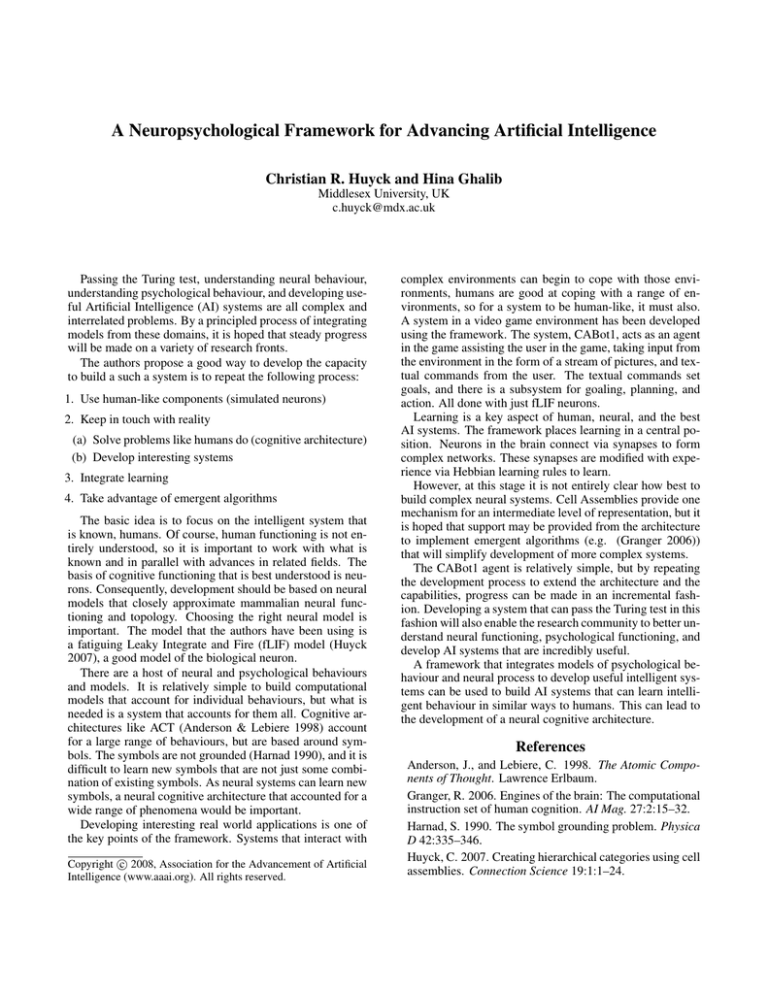
A Neuropsychological Framework for Advancing Artificial Intelligence
Christian R. Huyck and Hina Ghalib
Middlesex University, UK
c.huyck@mdx.ac.uk
Passing the Turing test, understanding neural behaviour,
understanding psychological behaviour, and developing useful Artificial Intelligence (AI) systems are all complex and
interrelated problems. By a principled process of integrating
models from these domains, it is hoped that steady progress
will be made on a variety of research fronts.
The authors propose a good way to develop the capacity
to build a such a system is to repeat the following process:
1. Use human-like components (simulated neurons)
2. Keep in touch with reality
(a) Solve problems like humans do (cognitive architecture)
(b) Develop interesting systems
3. Integrate learning
4. Take advantage of emergent algorithms
The basic idea is to focus on the intelligent system that
is known, humans. Of course, human functioning is not entirely understood, so it is important to work with what is
known and in parallel with advances in related fields. The
basis of cognitive functioning that is best understood is neurons. Consequently, development should be based on neural
models that closely approximate mammalian neural functioning and topology. Choosing the right neural model is
important. The model that the authors have been using is
a fatiguing Leaky Integrate and Fire (fLIF) model (Huyck
2007), a good model of the biological neuron.
There are a host of neural and psychological behaviours
and models. It is relatively simple to build computational
models that account for individual behaviours, but what is
needed is a system that accounts for them all. Cognitive architectures like ACT (Anderson & Lebiere 1998) account
for a large range of behaviours, but are based around symbols. The symbols are not grounded (Harnad 1990), and it is
difficult to learn new symbols that are not just some combination of existing symbols. As neural systems can learn new
symbols, a neural cognitive architecture that accounted for a
wide range of phenomena would be important.
Developing interesting real world applications is one of
the key points of the framework. Systems that interact with
c 2008, Association for the Advancement of Artificial
Copyright Intelligence (www.aaai.org). All rights reserved.
complex environments can begin to cope with those environments, humans are good at coping with a range of environments, so for a system to be human-like, it must also.
A system in a video game environment has been developed
using the framework. The system, CABot1, acts as an agent
in the game assisting the user in the game, taking input from
the environment in the form of a stream of pictures, and textual commands from the user. The textual commands set
goals, and there is a subsystem for goaling, planning, and
action. All done with just fLIF neurons.
Learning is a key aspect of human, neural, and the best
AI systems. The framework places learning in a central position. Neurons in the brain connect via synapses to form
complex networks. These synapses are modified with experience via Hebbian learning rules to learn.
However, at this stage it is not entirely clear how best to
build complex neural systems. Cell Assemblies provide one
mechanism for an intermediate level of representation, but it
is hoped that support may be provided from the architecture
to implement emergent algorithms (e.g. (Granger 2006))
that will simplify development of more complex systems.
The CABot1 agent is relatively simple, but by repeating
the development process to extend the architecture and the
capabilities, progress can be made in an incremental fashion. Developing a system that can pass the Turing test in this
fashion will also enable the research community to better understand neural functioning, psychological functioning, and
develop AI systems that are incredibly useful.
A framework that integrates models of psychological behaviour and neural process to develop useful intelligent systems can be used to build AI systems that can learn intelligent behaviour in similar ways to humans. This can lead to
the development of a neural cognitive architecture.
References
Anderson, J., and Lebiere, C. 1998. The Atomic Components of Thought. Lawrence Erlbaum.
Granger, R. 2006. Engines of the brain: The computational
instruction set of human cognition. AI Mag. 27:2:15–32.
Harnad, S. 1990. The symbol grounding problem. Physica
D 42:335–346.
Huyck, C. 2007. Creating hierarchical categories using cell
assemblies. Connection Science 19:1:1–24.





